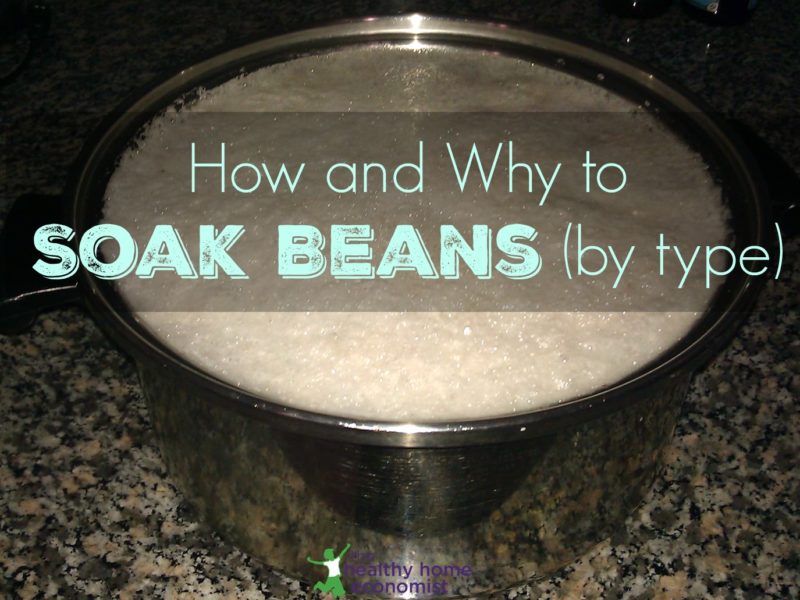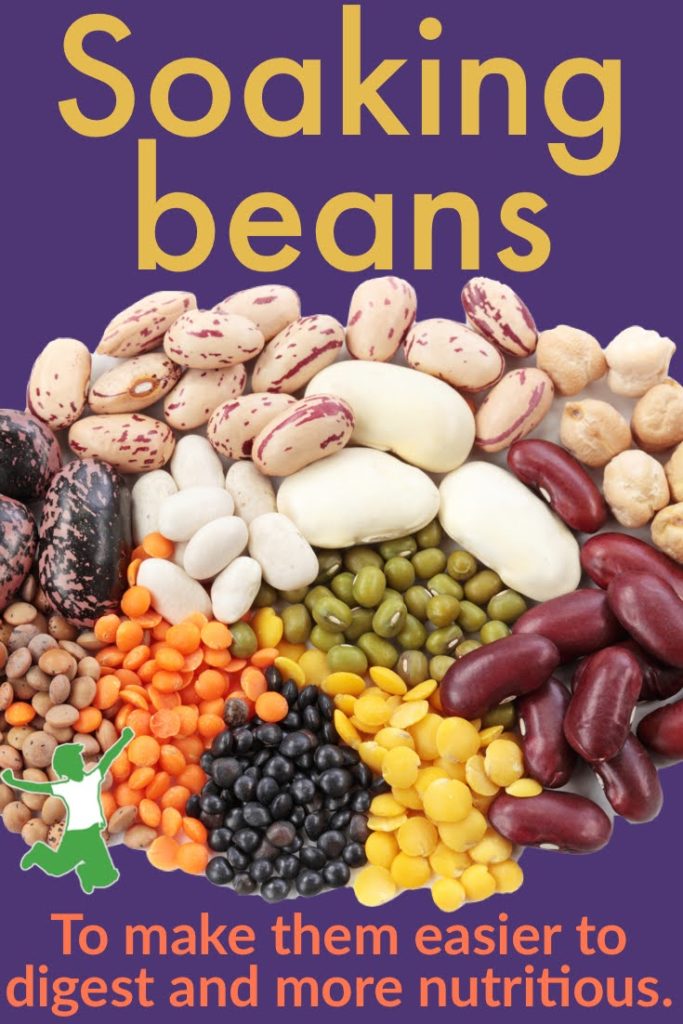Table of Contents[Hide][Show]
The simple overnight process of how to soak beans (by type) will help to eliminate gas and intestinal issues so you can enjoy eating these nutritious plant foods again!

I went on a bean soaking binge this past weekend, and the amount of scum that came to the top of the large pot of soaking kidney beans was so huge, I thought it deserved its own blog post. Soaking beans for many hours before cooking them produces a lot of scum which is course, is rinsed and drained away when the soaking is complete.
What is all that scum anyway? Anti-nutrients, that’s what! And those anti-nutrients such as phytic acid, lectins, and enzyme inhibitors are going to be in your gut causing you gas, heartburn, reflux, and whatever other digestive ills beset you when you eat something that isn’t particularly digestible unless you soak your beans before cooking them.
Traditional cultures took great care to prepare their legumes with a long soak before cooking to enhance digestibility and nutrient absorption.
I love Mexican food but really try to avoid Mexican restaurants for this reason .. they don’t soak their beans before cooking them!
After a meal at a Mexican restaurant, I will typically feel very bloated. Eating the same meal prepared at home where I soaked the beans properly before cooking results in no digestive upset whatsoever.
Take the Soaked Beans Challenge!
If you think unsoaked beans don’t cause you any trouble .. take this challenge. Soak beans next time before cooking and notice the difference in your stomach after eating.
You may think that the unsoaked beans don’t cause you any trouble, but you just may find that soaked beans are infinitely more filling and that you eat less and enjoy the meal more as a result!
Traditional peoples were very wise in the preparation of their foods. They not only selected nutritious foods but they prepared them for maximum digestibility and nutrition.
What good is eating nutritious legumes if the body is so whacked by the anti-nutrients that it can’t very easily extract and digest the nutrition?
So, the next time you make your beans, make sure you soak them first!
I soak large pots of various types of beans every month or so and then cook them – freezing for easy, quick meals when beans are required like homemade chili.
**If you absolutely do not have time to do this, at least buy pre-soaked legumes and beans packed in glass jars. Your digestion will thank you!
How To Prepare Beans by Soaking (video tutorial)
If you’ve never soaked beans before, it’s so easy. It’s a very similar process to soaking nuts. The method also mimics the wisdom of traditional societies that soaked seeds.
See this short video below that demonstrates the simple process.
Kidney shaped beans
For kidney shaped beans and dried/split peas, put a pinch of baking soda and enough water to cover in a large pot and soak uncovered for 12-24 hours. Drain, rinse and cook as usual.
Examples of kidney-shaped beans include:
- Red kidney beans
- White kidney beans (cannellini beans)
- Pinto beans
- Anasazi beans
- Black-eyed beans (black-eyed peas)
- Great Northern beans
- Lima beans
Non-kidney shaped beans (and other legumes)
For more oval-shaped beans and other legumes, soak for 12-24 hours in filtered water to cover plus 1 tablespoon of cider vinegar or lemon juice for every cup of dried beans/legumes used.
A homemade apple cider vinegar recipe or store-bought are both fine (make sure the ACV is packed in glass). Liquid whey from yogurt, kefir, or clabbered milk may also be used. Drain, rinse, and cook as usual.
Examples of non-kidney shaped beans include:
- Black beans (turtle beans)
- Navy beans
- Fava beans
- Adzuki beans
- Chickpeas
- Lentils
For maximum digestibility, it is best to rinse and refresh the filtered water and baking soda or the acidic medium once or twice during the soaking period. If you forget, no worries.
I try to always soak beans for the full 24 hours instead of just overnight. Sometimes if I get busy, I might even soak them 36 hours, but this is risky as they can get moldy sometimes if you go over 24 hours. Best to stay between 12-24 hours particularly during summer months.
How to Cook Beans After Soaking
After soaking, be sure to thoroughly drain and rinse the beans until all the scum is washed away. Then, complete the process by doing the following.
- Fill the pot of rinsed pre-soaked beans with fresh filtered water, bring to a boil, and skim away any additional foam that may come to the top at the start of the boil.
- Turn down the heat to a simmer, add 4 crushed garlic cloves, and cook until the beans are soft (about 4 hours).
- Drain beans and add to your favorite dish or let cool and freeze in large freezer bags for quick meals at a later date!
You won’t be needing over-the-counter gas meds after preparing beans the traditional way!
Should You Use the Soaking or Cooking Water?
Some alternative cooking circles advocate using the soaking or bean cooking water. Unfortunately, neither of these practices is traditional.
Using the cooked bean water or aquafaba is actually a dangerous practice. See the linked article for reasons to avoid this modern food especially during pregnancy!
Other Types of Legumes
This article plus video on soaking lentils provide additional information specifically for this legume. Because they are soaked exactly the same as all non-kidney shaped beans, it is helpful for visual learners.
Lentils were the favorite of nutritional pioneer Dr. Weston A. Price due to their very high potassium content.
Recipes Using Pre-soaked Beans and Legumes
Here are some recipes to try using soaked beans and other legumes to entice you!









Hi there colleagues, its enormous piece of writing on the topic of
tutoringand completely defined, keep it up all the
time.
Hi Sara,
Thank you for your article.
I realize your entry is over a year old but wonder if you can help me. (I could read through the comments, but I don’t normally as comments mostly produce contemptuous threads.)
—
I soaked Kidney Beans for the first time ever last night. Apparently, I did not use enough filtered water as there was no water left this AM. Consequently there was no scum to be removed either. I filled it up some more this morning but I’m not confident that I’ll have the desired results.
What do you think?
Some notes on what I did:
I used a plastic bowl, instead of a pot;
I used four cups of beans (I wanted more than two cups);
I “covered” the beans with water meaning I only went two inches over the top of beans.
Anything you can offer will be appreciated.
I know this is a very old comment, but… Did you check the beans at any point during the soaking? In my experience, they soak up the water pretty fast. When I first started soaking beans, I added what I thought was enough water… and when I checked two hours later, it was all gone. This is likely what happened to you. I would guess they probably didn’t turn out the way you’d hoped.
Try splitting into multiple pots (I wouldn’t recommend plastic bowls) and adding way more water than you think necessary. It’s going to get dumped anyway so it probably won’t hurt to add extra (though it may dilute the acid medium a bit).
Does anyone use a pressure cooker for cooking beans? It is no problem to start off by boiling with the lid off so that scum can be skimmed off.
Beans are great and having them ready ahead of time is so convenient, especially in summer. I am just no a fan of steaming up the kitchen in the summer and the pressure cooker is so much faster!
So, the GAPS book I have said I should soak my beans in whey for a week… Its day 2 and starting to smell. Is this normal? Everyone else seems to soak their beans for a much shorter period of time. Did you have success with a one week bean soak when you did GAPS Sarah?
On Lord. I just soaked dried chickpeas for the first time. It was closed to 36 hours and it is HOT here with no a/c (temps in the upper 90s the last few days). Anyway, that scum was absolutely disgusting…smelled weird. I’m going to cook them overnight in the crockpot on low but is the weird smell normal?
I am in the process of taking out as much processed foods as possible for my family. Soaking beans as I type! I was wondering what the “NT” that keeps getting referred to is? Seems like something I need to get my hands on! Thanks
In case nobody answered you it’s Nourishing Traditions by Sally Fallon and YES you definitely need to get your hands on a copy. Pretty inexpensive on Amazon but your library might carry it too if you want to review it first.
I tried something different, since I have type 2 diabetes, my blood sugar rises from eating pasta, I tried soaking my pasta in some apple cider vinegar and water. Cooked it for a few minutes because it becomes soft while the soaking. I noticed my blood sugar did not shoot up this time compared to just cooking it straight. I believe the starch and sugars were removed during soaking the pasta which made it easier to digest. I can now eat pasta! 🙂 Mind you I do not eat it often, maybe once in a week, since my diet is SCD. I can eat bread now too, that is a Sourdough Rye bread and my blood sugar does not go up then too. Lately I have also added greek yogurt to my diet (which I make at home, its cheaper) I eat about 6 to 8 oz a day. I always use to get bloated all the time and now I do not bloat at all, in fact I have lost some weight. I also do the same with lentils and beans I always soak them over night before cooking it.
For the pasta soaking (regular white pasta) 1 portion, I use 1/2 cup of pasta, 1 tablespoon of ACV and 1 cup of water, soak it for 3-4 hours then drain, rinse and cook in a fresh pot of water for 5 minutes. The taste of the pasta was not affected from the vinegar soak. Thanks for your blogging on soaking, it was great information, it has helped me alot. I suggest trying it!
I did this and it gave me terrible gas! It was better before when I didn’t soak them!